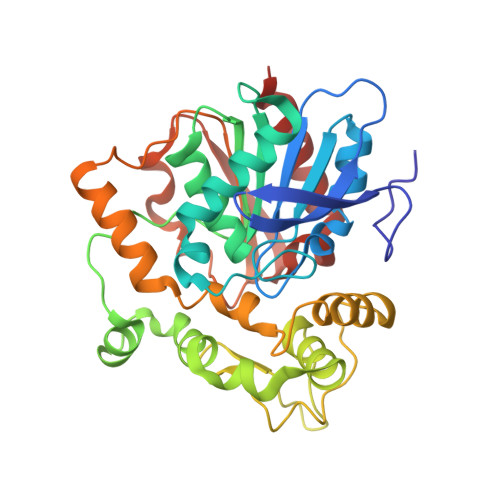The molecular structure of an epoxide hydrolase from Trichoderma reesei in complex with urea or amide-based inhibitors.
de Oliveira, G.S., Adriani, P.P., Ribeiro, J.A., Morisseau, C., Hammock, B.D., Dias, M.V.B., Chambergo, F.S.(2019) Int J Biol Macromol 129: 653-658
- PubMed: 30771398
- DOI: https://doi.org/10.1016/j.ijbiomac.2019.02.070
- Primary Citation of Related Structures:
6N3K, 6N3Z, 6N5F, 6N5G, 6N5H - PubMed Abstract:
Epoxide hydrolases (EHs) are enzymes involved in the metabolism of endogenous and exogenous epoxides, and the development of EH inhibitors has important applications in the medicine. In humans, EH inhibitors are being tested in the treatment of cardiovascular diseases and show potent anti-inflammatory effects. EH inhibitors are also considerate promising molecules against infectious diseases. EHs are functionally very well studied, but only a few members have its three-dimensional structures characterized. Recently, a new EH from the filamentous fungi Trichoderma reseei (TrEH) was reported, and a series of urea or amide-based inhibitors were identified. In this study, we describe the crystallographic structures of TrEH in complex with five different urea or amide-based inhibitors with resolutions ranging from 2.6 to 1.7 Å. The analysis of these structures reveals the molecular basis of the inhibition of these compounds. We could also observe that these inhibitors occupy the whole extension of the active site groove and only a few conformational changes are involved. Understanding the structural basis EH interactions with different inhibitors might substantially contribute for the study of fungal metabolism and in the development of novel and more efficient antifungal drugs against pathogenic Trichoderma species.
Organizational Affiliation:
Escola de Artes, Ciências e Humanidades, Universidade de São Paulo, 1000 Arlindo Bettio Avenue, 03828-000 São Paulo, Brazil.















